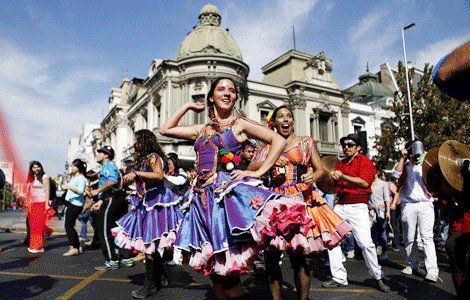Powerful punch comes from brain: study
Updated: 2012-08-16 06:54
(Xinhua)
|
||||||||
LONDON - Karate experts' ability to punch powerfully is associated with distinctive features in their brain structure, according a latest British study published here on Wednesday.
Imperial College London said in a statement that its researchers have looked for differences in brain structure between 12 karate practitioners with a black belt rank and an average of 13.8 years karate experience, and 12 others of similar age who exercised regularly but did not have any martial arts experience.
The researchers tested how powerfully the subjects, who wore infrared markers on their arms and torso to capture the speed of their movements, could punch from a short distance of five centimetre.
They reported in the journal Cerebral Cortex that
The karate group was found to be able to punch harder as expected, and the force they generated correlated with how well the movement of their wrists and shoulders were synchronized.
Brain scans showed difference of brain structure between the two groups in the white matter of the brain regions called cerebellum and the primary motor cortex, which are known to be involved in controlling movement.
White matter in the brain is mainly made up of bundles of fibers that carry signals from one region to another.
The difference correlated with the synchronicity of the subjects' wrist and shoulder movements when punching. The findings suggest that the structural differences in the brain are related to the karate experts' punching ability.
"The karate black belts were able to repeatedly coordinate their punching action with a level of coordination than novices can't produce," said Dr. Ed Roberts at Imperial College London.
"We think that ability might be related to fine tuning of neural connections in the cerebellum, allowing them to synchronize their arm and trunk movements very accurately."

 Relief reaches isolated village
Relief reaches isolated village
 Rainfall poses new threats to quake-hit region
Rainfall poses new threats to quake-hit region
 Funerals begin for Boston bombing victims
Funerals begin for Boston bombing victims
 Quake takeaway from China's Air Force
Quake takeaway from China's Air Force
 Obama celebrates young inventors at science fair
Obama celebrates young inventors at science fair
 Earth Day marked around the world
Earth Day marked around the world
 Volunteer team helping students find sense of normalcy
Volunteer team helping students find sense of normalcy
 Ethnic groups quick to join rescue efforts
Ethnic groups quick to join rescue efforts
Most Viewed
Editor's Picks

|

|

|

|

|

|
Today's Top News
Health new priority for quake zone
Xi meets US top military officer
Japan's boats driven out of Diaoyu
China mulls online shopping legislation
Bird flu death toll rises to 22
Putin appoints new ambassador to China
Japanese ships blocked from Diaoyu Islands
Inspired by Guan, more Chinese pick up golf
US Weekly

|

|






